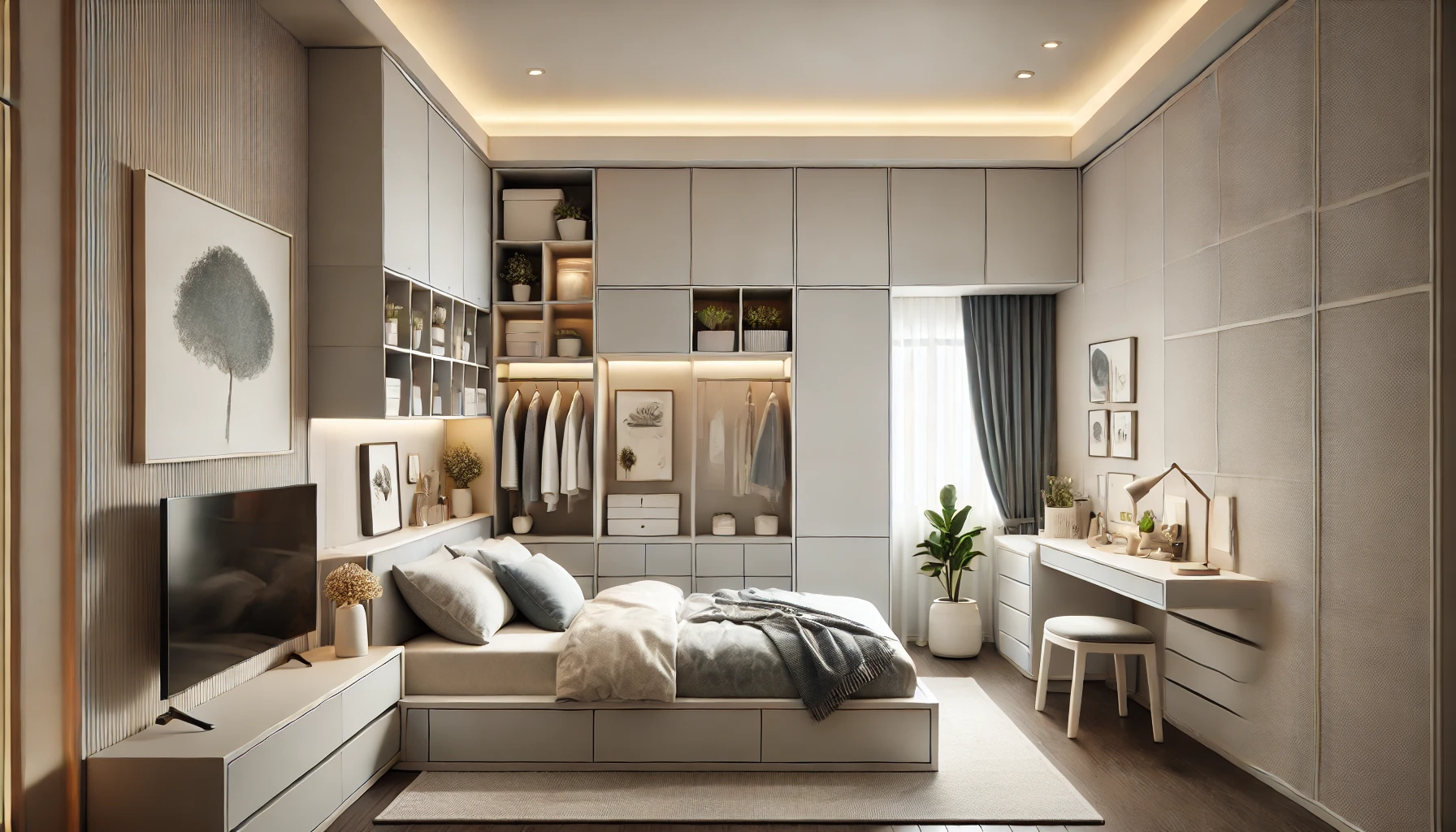Creating a bedroom that reflects your personality, meets your practical needs, and maximizes available space can be challenging. One of the most effective ways to achieve this is by designing a modular bedroom. Modular furniture is not only functional and flexible but also customizable to fit diverse styles and room sizes. In this article, we’ll explore how you can design a modular bedroom that fits your unique style, incorporating expert tips, practical ideas, and design principles to help you create the ideal space for rest and relaxation.
What is Modular Bedroom Design?
Modular bedroom design refers to a furniture layout that uses individual, interchangeable pieces to create a personalized and functional space. These modular components—such as beds, wardrobes, shelves, and dresser table can be combined and arranged in countless configurations, offering flexibility for small or large spaces.
This design style is rooted in the concept of efficiency, allowing you to make the most of your bedroom’s size and shape while incorporating elements of your personal taste. Modular furniture is perfect for homeowners and renters alike, as it can easily adapt to changing needs over time. Additionally, the ability to modify and expand your setup means you can refresh the look and function of your bedroom without significant investments in new pieces.
Benefits of a Modular Bedroom
One of the primary benefits of a modular bedroom is its versatility. Whether you live in a studio apartment or a spacious home, modular furniture adapts to your space. This type of design is ideal for making small rooms feel larger, as pieces can be tailored to fit snugly in corners or along walls.
Another advantage is customization with modular pieces, you can choose the materials, colors, and finishes that match your style. Beyond aesthetics, modular furniture is also incredibly functional. For example, beds with built-in storage help eliminate clutter, while modular shelving units can be rearranged as your needs change. This flexibility ensures that your bedroom remains a reflection of your evolving preferences without needing a full redesign.
Understanding the E-E-A-T Principles for Bedroom Design
When it comes to designing a modular bedroom. Experience plays a pivotal role in understanding how various modular elements come together to create a harmonious space.
Professional designers often incorporate their experience to recommend modular furniture that balances function, aesthetics, and comfort. Expertise in understanding materials and finishes, as well as design techniques, helps in creating a cohesive look. When sourcing your furniture, it’s important to purchase from reputable and authoritative brands or designers who are known for their quality and design standards.
Lastly, trustworthiness comes from selecting furniture that is durable and from sources that offer customer support and transparent service. When all these elements come together, your modular bedroom will be not only stylish but also enduring.
Planning Your Modular Bedroom Layout
The first step in designing your modular bedroom is to plan the layout. Consider the size and shape of your room—how much space is available, and where each piece will fit most efficiently. If you have a small space, opt for modular furniture that offers multi-functional features, like a bed with built-in storage or a desk that doubles as a nightstand.
For larger rooms, you can incorporate multiple modular components to define different zones, such as a reading nook or a workspace. When placing furniture, keep flow and accessibility in mind. A well-planned layout will create a functional and comfortable environment, allowing you to move around freely while maintaining a cohesive look.
You can experiment with various configurations of the modular pieces before committing to a final setup. The flexibility of modular furniture allows you to adjust your design until it feels just right for you.
Selecting the Right Modular Furniture for Your Bedroom
When designing a modular bedroom, the type of furniture you choose is crucial to achieving a cohesive style. Start by selecting the core pieces—such as the bed and wardrobe—that will anchor the design. Then, complement these with modular shelves, dressers, and nightstands that fit within the space.
Look for pieces that serve dual purposes, like a modular sofa that can transform into extra sleeping space or a bedside table with storage. Choosing furniture that offers adaptability is important, as you can rearrange or add to the setup as your lifestyle changes.
Pay attention to the materials used in the furniture as well; wood offers warmth and a classic look, while metal can lend a more modern and industrial feel. Consider the overall aesthetic of your room when choosing your furniture’s finish, as the right combination of materials and colors can bring your vision to life.
Maximizing Storage in a Modular Bedroom
Storage is one of the most important considerations when designing a modular bedroom, especially for smaller spaces. Modular furniture often includes built-in storage solutions such as drawers, shelves, and cabinets.
For a more efficient use of space, look for a bed with storage underneath or opt for modular shelving units that can be adjusted as needed. You can also create a custom closet solution with modular wardrobe systems, which allow you to add extra shelves, hangers, and drawers as your needs grow. When planning your storage, think vertically as well as horizontally.
Tall, narrow shelving units can provide plenty of storage without taking up too much floor space. Additionally, multifunctional pieces, like a desk with built-in drawers, can help consolidate your belongings while keeping your room tidy. With modular designs, you can ensure that every corner of your bedroom serves a purpose.
Choosing the Right Color Palette for Your Modular Bedroom
Color plays a significant role in determining the atmosphere of a bedroom. When designing a modular bedroom, choose a color palette that complements the furniture and enhances the overall mood. For a calm and serene environment, opt for soft, neutral tones like whites, creams, and light grays. These colors create a peaceful backdrop for your modular furniture and can make smaller rooms feel more spacious.
On the other hand, if you want a more dynamic and vibrant bedroom, incorporate rich, bold colors like deep blues, greens, or even earthy tones like terracotta. Modular furniture offers flexibility, allowing you to experiment with color combinations. For example, you can mix and match different modular pieces in contrasting shades or use accent walls to create focal points in the room. The right color scheme will not only elevate the design but also help you establish the perfect ambiance for relaxation and rest.
Incorporating Personal Touches into Your Modular Bedroom
One of the key advantages of modular design is its ability to reflect your unique style. After you’ve chosen the primary furniture pieces and color palette, add personal touches that make the space feel like your own. Decorative pillows, throws, and rugs are excellent ways to inject personality into your modular bedroom.
You can also incorporate artwork, mirrors, and plants to create a cozy, inviting atmosphere. Modular furniture allows you to experiment with different textures and finishes, so feel free to mix wood, metal, and fabric elements for a layered, personalized look. Lighting is another important factor—consider adding floor lamps or pendant lights to create a warm, soft glow that complements the room’s design. Remember, your bedroom should be a sanctuary that reflects your personality and lifestyle, so be sure to infuse elements that bring you joy and comfort.
Sustainability in Modular Bedroom Design
As more people become conscious of environmental impact, sustainable design choices are increasingly important. When designing a modular bedroom, consider opting for furniture made from sustainable materials such as reclaimed wood, bamboo, or eco-friendly upholstery. Many modular furniture manufacturers are also adopting eco-conscious practices, using non-toxic finishes and environmentally friendly packaging.
By choosing modular pieces made from these materials, you contribute to a more sustainable living space. Additionally, modular furniture’s durability and adaptability mean it can last for years, reducing the need for frequent replacements. This longevity not only benefits the environment but also saves you money in the long run. Sustainable design doesn’t have to mean sacrificing style or comfort many modular pieces are both eco-friendly and aesthetically pleasing, so you can create a beautiful, functional bedroom while being kind to the planet.
Conclusion
Designing a modular bedroom that fits your style involves a mix of creativity, functionality, and careful planning. By choosing the right furniture, layout, color palette, and storage solutions, you can create a space that reflects your personality and enhances your everyday life. Modular design offers the flexibility to adapt as your needs change, making it a smart and sustainable choice for homeowners and renters alike



